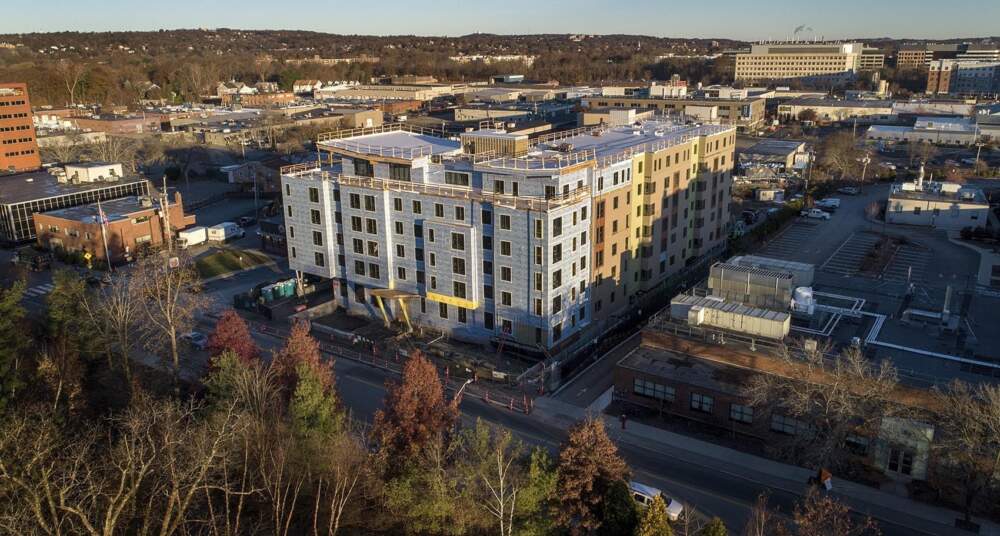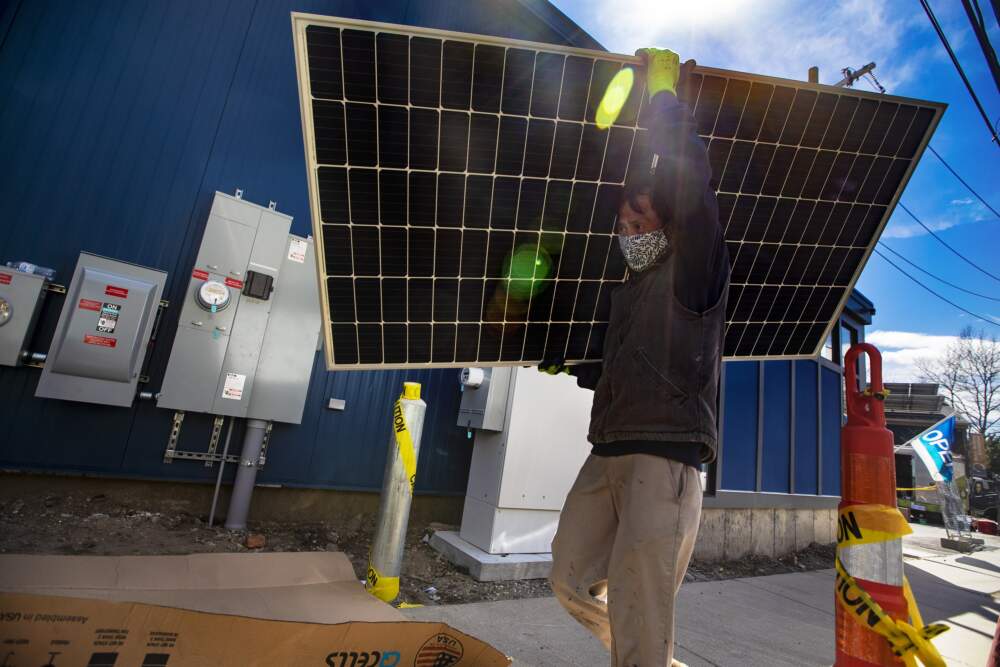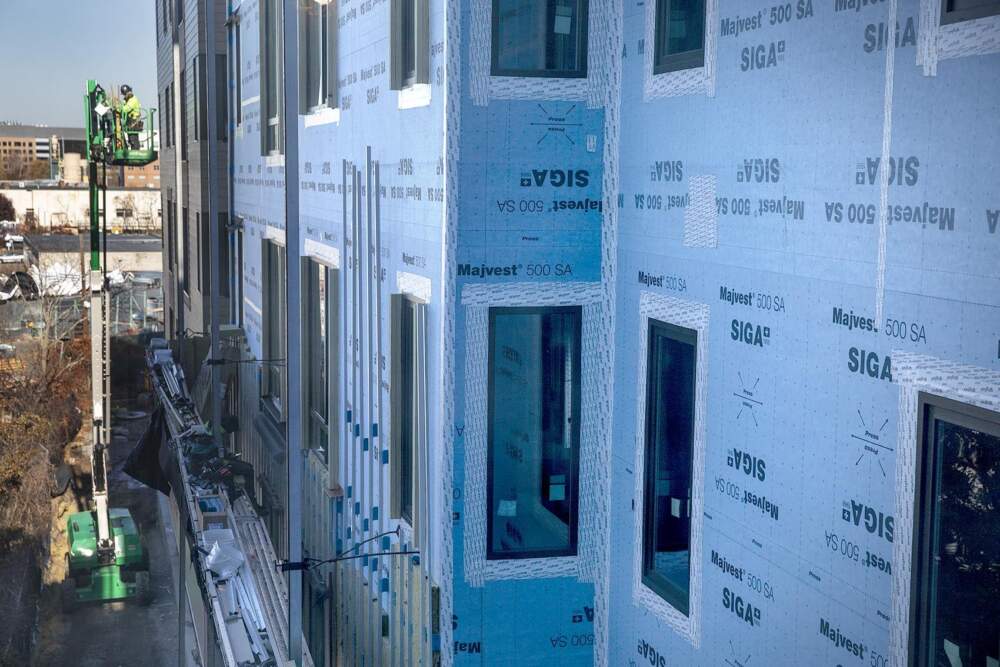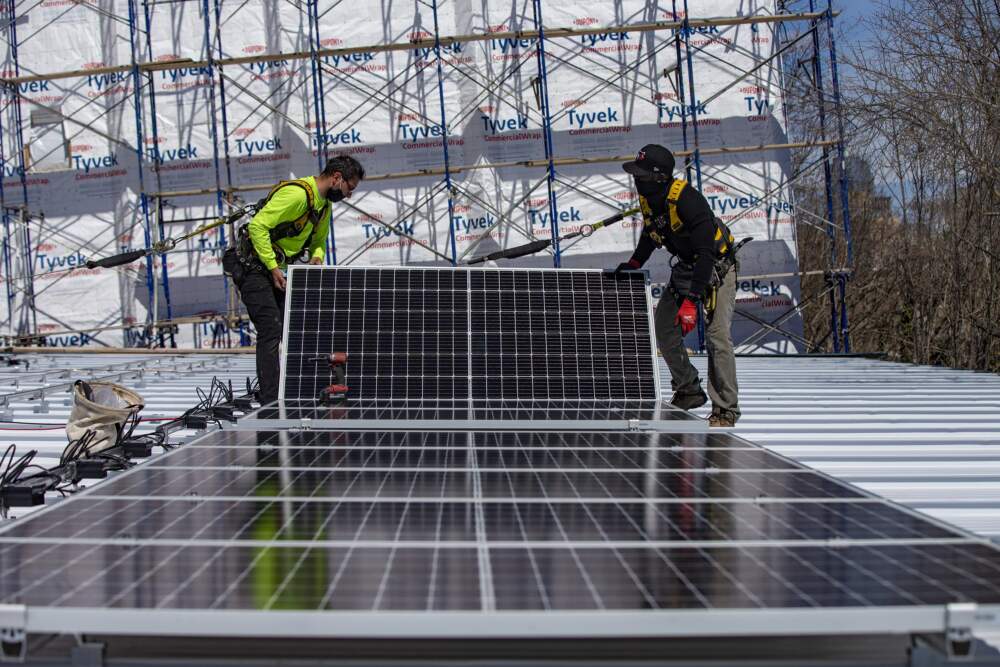Advertisement
Massachusetts' new 'green bank' for climate-friendly housing, explained

Massachusetts recently established a “green bank” to help finance new climate-friendly affordable housing and retrofit existing buildings so that they’re more energy efficient and fossil fuel-free.
Officially known as the Massachusetts Community Climate Bank, Gov. Maura Healey said the green bank will jumpstart “green building and renovation projects” to help the state meet its climate goals, and that it will help bring down housing and energy costs for low-income residents.
“This is about creating green liveable communities,” Healey said.
“Okay,” you might be asking, “but what is a green bank and will it help me retrofit my house?”
If you’re the type of person whose eyes glaze over at terms like “leverage private capital” and “de-risk loans,” here’s what you need to know:
What is a green bank?
Green banks are mission-driven institutions that make it easier and more affordable to borrow money for climate-friendly projects. As a policy tool, they’re used to fill market gaps and influence certain environmental or economic development outcomes.
"We are picking winners," said Larry Chretien, executive director of the Green Energy Consumers Alliance. "We're putting our thumb on the scale for projects that we need in the state."
Green banks can be operated by public entities like states or municipalities, nonprofits or quasi-public agencies, as is the case in Connecticut, which has the country’s oldest green bank. They can help finance a wide variety of projects — everything from rooftop solar panels and energy efficiency upgrades, to renewable energy projects and “clean transportation” efforts.
But what’s important, and what makes a green bank notable, is that it is not a grant-giving entity. It’s a financial institution that lends money and works to attract — or “leverage” — federal or private money. To give a real-world example of this impact, the Connecticut Green Bank has been able to bring in about $7 of private money for every $1 of state money it puts up.
Advertisement
It’s this ability to make a small pot of state money go further that represents the real engine behind a green bank.
How does a green bank work?
It depends on the bank. But generally speaking, a green bank provides a better deal for borrowers than the market would otherwise offer. The goal is to help borrowers afford to build certain types of projects — fossil fuel-free affordable housing, for example — or nudge them to do so.
“It’s adding sweeteners for someone who's going out looking for financing to build something, to make sure that they're building it the way that we want to see it built from a public policy perspective,” said Caitlin Peale Sloan, the vice president of the Conservation Law Foundation in Massachusetts.
This could mean offering loans with low-interest rates and long repayment periods. It could mean financing projects that other lending institutions might consider too risky. Or it could mean assuming liability if a borrower can’t pay back the money.
How does a green bank choose which projects to finance?
Green banks have in-house experts to evaluate the merits of green projects, so if they’re willing to help finance something, it can send a signal to other lending agencies that this is a safe investment.
“Green banks have a specialty in the green economy,” said Vick Mohanka, acting deputy director of the Massachusetts Sierra Club. “They understand how to make loans, how to underwrite, how to vet projects — all of those kinds of things that regular banks don't.”
For example, let’s say a green bank evaluates and decides to support a proposal to build an all-electric, energy efficient affordable housing project. The green bank may put up 20% of the money at a low-interest rate and encourage another bank to loan the other 80% at the same below-market rate. Alternatively, the green bank could work with ten outside lenders and get them to help fund 100 projects.
“Everyone's got a little tiny piece of a big package, and that diversifies the risk,” Chretien said. “The goal here is that this grows to being a vibrant pool [where] money flows in and out and there are a lot of deals.”

So why would a traditional bank or other lending institution want to participate? It could help it meet its federal Community Reinvestment Act requirements or “ESG” — environmental, social, and corporate governance — goals. It could net some good PR. Or the institution might like the idea of the state streamlining the pre-approval process and assuming much of the risk.
“This is a really successful and proven model,” said David Melly, the Environmental League of Massachusetts’ legislative director. “It has shown great impacts from an equity perspective in terms of the investments directly benefiting folks that wouldn’t otherwise benefit from standard decarbonization incentives.”
What is the Massachusetts green bank and why is it unique?
According to the Healey administration, the Massachusetts Community Climate Bank is the first green bank in the country dedicated to affordable housing projects. It will be operated by MassHousing, the state’s independent affordable housing finance and investment bank, and work closely with the state’s clean energy development agency, the Massachusetts Clean Energy Center, and the state's finance and development agency, MassDevelopment.
The state is “seeding” — or starting — the bank with $50 million from the Department of Environmental Protection, which officials said puts it in a good position to apply for millions more from the federal government.
“The Biden administration is making historic levels of funding available for clean energy, carbon reduction and climate action. We're talking about billions of dollars in grant funding, tax credits and more through the Inflation Reduction Act,” Gov. Healey said. “And this is the opportunity that we are seizing.”
The Inflation Reduction Act has billions of dollars for all sorts of green projects, and a green bank is a good repository for a lot of that money.
“I think the Green Bank of Massachusetts will be essentially an intermediary between the federal money and the borrowers in Massachusetts,” Chretien said.
It could help landlords or nonprofits pay for climate-friendly building upgrades. It could help persuade developers to build new green and affordable units instead of a different project. And the beneficiaries will be many of the same people who currently pay disproportionately high energy bills and are most affected by climate change.
Will the green bank really help Massachusetts reduce emissions?
It’s not clear how much Massachusetts will get from the federal government, but experts say it’s likely to be much more than the $50 million the state contributed. And armed with this big pot of money — plus the private money it hopes to bring in — the green bank could theoretically help the state make a dent in one of the biggest climate obstacles it faces: reducing emissions from buildings.

There are over 2 million buildings in Massachusetts and the majority of them heat with fossil fuels. Collectively, buildings account for about 27% of the state’s annual carbon emissions, though that figure is much higher in some areas — in Boston, for instance, about 70% of the city’s carbon emissions come from buildings.
Because the majority of the state's current buildings will still be standing mid-century, “it's as important to retrofit a 100-unit affordable housing project as it is to build a brand new one,” Chretien said.
The state’s Clean Energy and Climate Plan calls for dramatically reducing emissions by converting existing buildings to electric sources of heat and “retrofitting” them to improve energy efficiency. To put some numbers to the task ahead, right now, only 15% of homes in Massachusetts heat with electricity; by 2030, the state wants 38% of homes electrified. And by 2050, it wants 80% of them converted.
Meeting these targets is going to be challenging and incredibly expensive — retrofitting one apartment or single-family home can easily cost upward of $30,000. The state’s energy efficiency program, Mass Save, offers rebates for things like heat pumps and energy efficient appliances, but that doesn’t necessarily help with upfront costs. And its interest-free loans might not cover the full expense of a building upgrade project.
Many environmental advocates worry that if only affluent residents can afford to electrify their homes, lower-income residents (many of whom already spend a high percentage of their monthly income on utilities) will be saddled with even bigger bills because they’re left paying for the fixed costs of the gas distribution system.
Who can use the green bank?
Well, it sorta remains to be seen.
The Healey administration says it will be open to a lot of people, but some advocates worry that despite the banks's efforts to focus on inequities, there may be issues with accessibility.
“It's not an intuitive thing to understand what a climate bank does unless you work in financing projects and investment,” Peale Sloan said. “And so we need a storefront, essentially, that an individual can go up to and say, 'I want to make my house more climate resilient,' and not have to shop around to a million different programs.”

A report released late last year about how the state can meet its building decarbonization goals suggested doing just that. The proposed “building decarbonization clearing house” would replace the state’s current energy efficiency program, Mass Save, and be a one-stop-shop for all things related to building electrification and retrofits.
The Healey administration is interested in the idea, and the governor allotted $4.8 million in her proposed 2024 budget to start planning and developing it.
Still, experts caution that even an accessible green bank is not a panacea to the state’s building decarbonization problems. It may help tackle a big portion of its housing and climate goals, “but it's an open question how much it will be able to impact the people who really just need free money,” Peale Sloan said.
A coalition of housing, climate and education activists have been pushing the Healey administration to take $300 million of remaining COVID relief funds and establish a building decarbonization grant program. So far, the administration hasn’t run with the idea, but earlier this year, it announced a different $50 million grant program for low-income residents who want to do climate-friendly upgrades. That money could start being awarded later this summer.
When will the bank be up and running?
There’s no set date for its launch, but the governor’s office says it will likely be later this year after the state knows more about how much federal money it’s receiving. Between now and then, the administration will continue working on the bank’s business plan, hire more staff and apply for federal funding opportunities.
One final note on the green bank: Though the focus right now is solely on climate-friendly affordable housing, the Healey administration has said it may broaden the mandate in the future. That is to say, there could come a time when the owner of a bus fleet could apply for a low-interest loan to buy electric vehicles, a clean energy developer could borrow money to build a solar farm and a school system could afford to retrofit all of its buildings.
